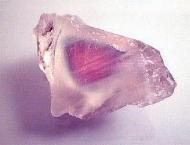Sunstone
The optical effect is due to reflections from inclusions of red copper, hematite, or goethite, in the form of minute scales, which are hexagonal, rhombic, or irregular in shape, and are disposed parallel to the principal cleavage-plane.
Previously the best-known locality being Tvedestrand, near Arendal, in south Norway, where masses of the sunstone occur embedded in a vein of quartz running through gneiss.
Other locations include near Lake Baikal in Siberia, and several United States localities—notably at Middletown Township, Delaware County, Pennsylvania; Plush, Oregon; and Statesville, North Carolina.
After much controversy and debate, most of these gemstones, allegedly sourced from China, were subsequently discovered to have been artificially colored by a copper diffusion process.
[2] A Tibetan source of bona fide (untreated) red andesine, however, was eventually verified by a number of independent groups of well-respected gemologists.


